
South Korea
Seoul![[Unesco]](/images/unesco-logo.gif)
![[+]](/images/icone-etoile.png)
I have not found a given nickname for the city of Seoul. South Korea, however, is nicknamed "the land of morning calm" though it appears to be an error
of translation as it is better translated as "country of morning fresh"...
In South Korea, each city has its miniature symbol figurine. For Seoul it is Haechi which derives from a korean mythical creature :
the haetae (which corresponds to the Chinese xiezhi).
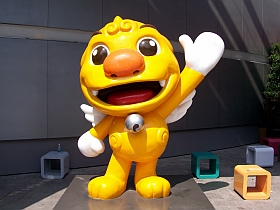
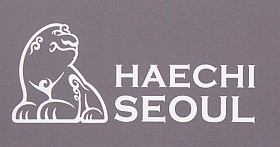
Royal palaces
There are several royal palaces in Seoul but only Changdeokgung Palace (the palace of the secret garden) and Jongmyo are classified by Unesco.
Gyeongbokgung : the palace of shining happiness
It's my favorite. Its location was not chosen by chance but by following the rules of feng sui, i.e. optimal qi (energy). In 1895, Queen Min was murdered there by the Japanese who were already aiming at the conquest of Korea (the invasion was launched in 1910).
The front door has two levels. At 11am, we can see the changing of the guard.
The Imperial palace is surrounded by a balustrade with representation of the zodiac animals and keepers. Near the central aisle there are marking stones which were used to indicate the position of each official during ceremonies.
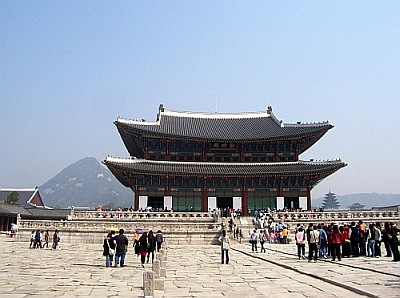
In the throne room of the king, we can see a screen in the background with 5 mountains, symbolizing the country -mountainous to 70%-, the sun which is also the yang, and the moon which is also the yin.
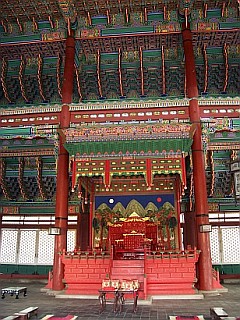
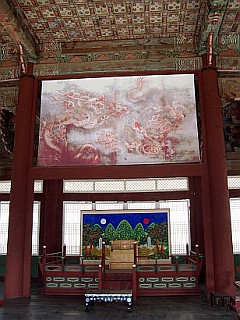
There are also nice views as below with the mountain of Bukhansan in the background, or the Hyangwonjeong pavilion, charming in all seasons.
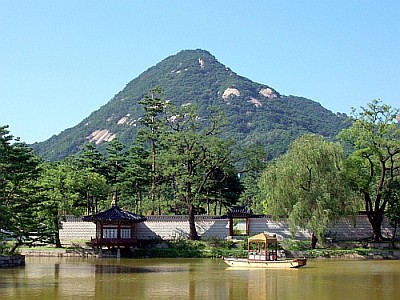
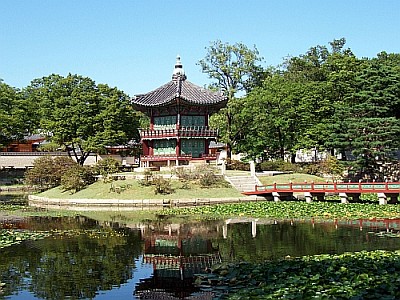
Changdeokgung : the palace of illustrious virtue
From Gyeongbokgung, one can go through Bukchon neighborhood with its traditional houses, called hanok, to reach Changdeokgung palace. This one is classified by Unesco. The secret garden, Biwon, was the royal garden. It is a large shady park with several pavilions.
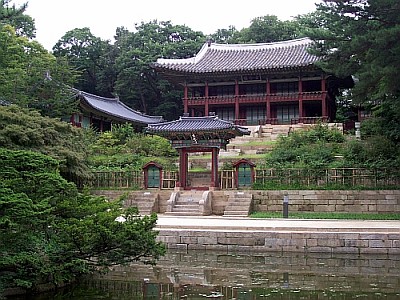
Changgyeonggung : the palace of prospering virtue
It also has a botanical garden and a taeshil (stone container containing the placenta of a prince, king or queen).
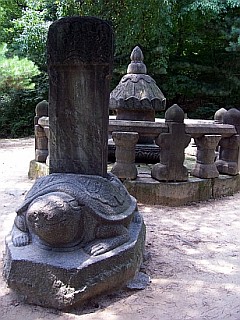
Deoksugung : the palace of virtuous longevity
To put on the visiting list : the changing of the guard. Below the palace with its stairs. The central portion was reserved for the king and the queen. Statues of mythical animals had the function to protect the access of the palace. Two dapdos (danbis in Chinese) or central slab was carved with dragon patterns, symbol of the king, and phoenix patterns, symbol of the queen.
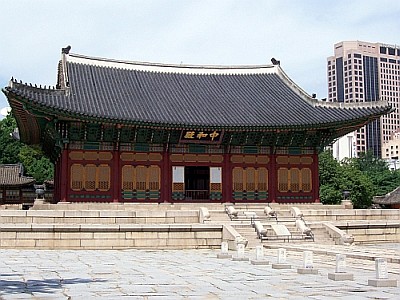
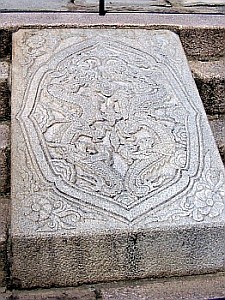
Inside the palace, one can also see a western-style building, the National museum of arts, and a statue of king Sejong under whom the Korean alphabet, hangul, was invented in the 15th century.
Gyeongheuigung
This palace seems closed to visitors, but we can do a quick tour of the outside. There are mulberry trees all around whose leaf is used to eat samgyeopsal (thin slices of grilled pork) by adding sauce and vegetables.
Unhyungung
This palace is interesting for its dummies dressed as in several hundreds years ago. The visit shows noandang (building of men), norakdang (building of women) and irodang (main building).
Jongmyo
It is classified by Unesco and houses the tablets of the kings of Joseon (which we did not see during the visit). It is the longest wooden building in Korea.
Confucian ceremonies (for ancestor worship) is held once a year on the first sunday of may.
The city gates
The Namdaemun gate is the symbol of the city or even the country but it has unfortunately suffered an arson attack in 2007 and was being rebuilt in 2009 so unfortunately, no pictures...
Another important gate is Dongdaemun gate. We can see on its roof patterns of dragons.
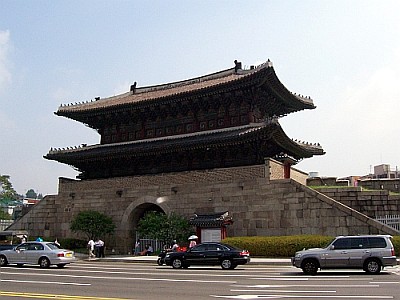
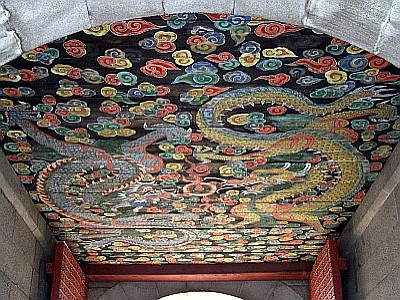
Namsan tower
Located on Namsan hill, the TV tower is a symbol of Seoul. There is a restaurant at the top where it is nice to have dinner by night. Below, general view of Namsan Hill and Han, a broad river which flows through Seoul.
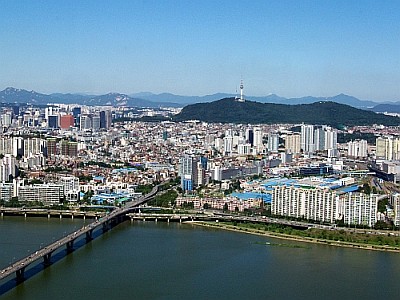
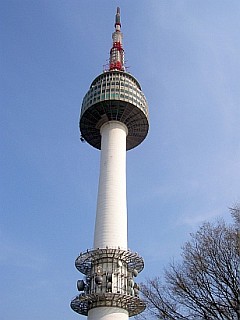
The center of Seoul
In the center of Seoul, on the main avenue, we can see the statue of Admiral Yi Sun-Sin.
In 1592, the Japanese army of emperor Hideyoshi invaded Korea but the Korean Admiral Yi Sun-sin, using his invention : the turtle boat, destroyed the Japanese fleet
though numerically superior. Depriving the Japanese of their logistics, the latter are forced to retreat in 1593 after a Chinese intervention.
Since late 2009, there is a statue of King Sejong, who lived in the 15th century and under whom the Hangul (Korean alphabet) was invented.
The cheonggyecheon is a small "stream" which edges were refurbished in 2005 to nearly 6 km.
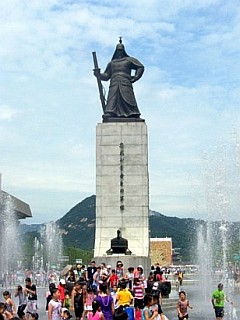
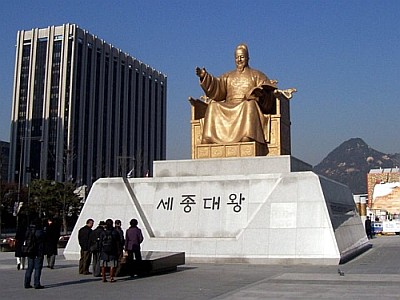
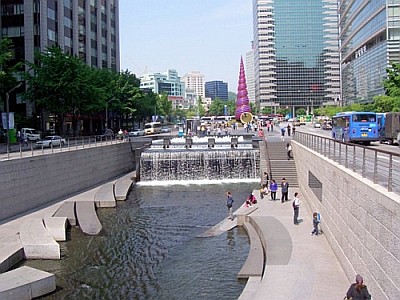
On one wall, a stunning 192 m (210 yards) long by 2.40 m (7.9 feet) tiles painting, reproduction of a picture of the book "Wonhaeng Eulmyo Jeongni Eugwae". It is both a painting and a documentary on the royal processions in king Jeonjo time (late 18th century). This "fresco" shows a procession from Changdeokgung palace to Suwon, where the king was going and meditate at his father's grave in commemoration of the 60th anniversary of his death. The procession had no less than 1779 people and 779 horses... (This reminds me of azulejos, tiles of Portugal).
Further on, the "wall of hope" is composed of tiles made by 20,000 people... The stones placed across the stream allow us to cross it,
but their primary function is to regulate its flow.
A spiral statue called "spring" was placed at the end of the stream in the center of the city to symbolize modernity.
See also, the statue of the man with the hammer symbolizing workers (there are others of the same artist, Jonathan Borovsky, worldwide, as in the business district of Frankfurt for example), the "sculptures" of earth and moss, typically Korean, large screens, Samsung tower (headquarters of this korean group)...
Pagoda and folk museum
The 10-story pagoda, a gift from a Mongol emperor to the Korean king who married his daughter in 1348, is located near Gyeongbokgung Palace.
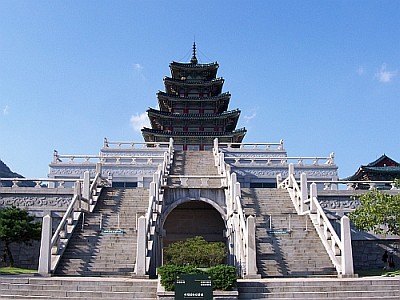
The a very interesting folk museum worth visiting and is located right under the pagoda.
National museum
It is a large museum with different galleries on Korea (art, culture, religion...). In the same kind, the museum of Gyeongju is worth the visit.
Insa-Dong
This is the main shopping and touristing street in Seoul and an ideal place for buying souvenirs. There are many shops that sell prints, masks, brushes, clothing (silk scarves), figurines, tea, kkul tarrea (kings delicacy, consisting of several thousand threads of honey and malt, prepared with dexterity in the street in front of customers) and many others such as an original 3-in-1 bookmark (see in the gallery). One can also have a seal (dojang or ingam) made with one's name. Finally, the visit would be incomplete without a stop at a traditional tea house. Nearby, there is a Chondogyo church, a typically Korean religion.
Yeouido
It is an island located on the Han River. You can ride a bike and get to the tower 63. The Full Gospel Church is a Protestant church that can hold up to 10,000 worshipers.
Wongudan
It is a temple built by a king of the late 19th century after having proclaimed himself emperor wanted to worship Heaven, as the China Emperor did.
Buddhist (and shamanist) temples
There are not many buddhist temples within Seoul boundaries as under the Joseon dynasty confucianism was privileged and buddhist monks were forced to leave the city and seek refuge in the mountains. Thus there are several temples in the mountains around Seoul, as Bukhansan (even if they are now inside the city as so it has extended a lot). However we can still get to 4 major temples in the capital without having to climb the montagnes :
- Jogyesa temple is located near Insa-Dong.
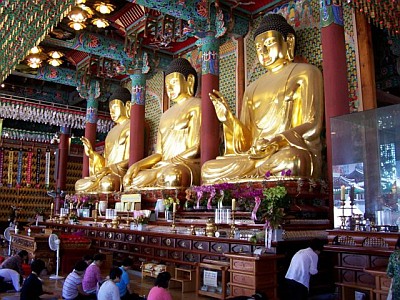
- Bongeunsa temple is located nearby Coex. It was the center of seon buddhism (the Korean zen cor├ęen). Relics of the historical Buddha (Sakyamuni) were brought from Skri Lanka in 1970 and deposited in the stupa in front of the main hall. In Korea, only 5 temples hold relics of Buddha (see Tongdosa temple). The statue of Mireuk (Maitreya in sanskrit : the buddha of the future), in granite, is 23 m (25 yards) high and so is the highest of its kind in Korea.
- Bongwonsa temple is located in the west of the city and is since 1970 the center of Taego sect who allows its priests to marry.
- Guksadang temple is a shamanistic temple located in Ingwansan mountain. It contains syncretic elements of buddhism.
Myong-Dong
The district of Myong-dong is made of several pedestrian shopping streets that lead up to the cathedral.
The cathedral Myong-Dong, dedicated to Our Lady of Lourdes, was built in the 19th century by a Father of the Paris Foreign Missions (MEP). In 2010, we could estimate Catholics to 10% in Korea (out of a total of 30 to 40% of Christians).
In Seoul, you can also visit Catholic martyrdom places : Jeoldusan, Saenamteo (see page catholic places).
Namsan folk village
The folk village shelters five traditional houses (Hanok) from the Joseon period. It is better to get ceremonies schedules holding there in order to be sure to enjoy the visit at its most.
More original, a "time capsule" has been buried here in 1994. Actually, to celebrate the 600th anniversary of Seoul, a capsule with 600 objects of everyday life (as CDs and microfilms) were locked in a capsule and buried. The capsule will be unearthed in 2394 to celebrate the 1,000 years of Seoul...
Coex
The Coex is both a large shopping mall and business district southeast of Seoul.
Tapgol park
The Tapgol park contains a 10-story stupa dating from 1466. In 1919, resistants to the Japanese occupation (since 1910) read there the Declaration of Independence they had written.
Independence park
The Independence Park was created to celebrate independence from China.
Seoul markets
There are several traditional markets in Seoul with the Korea's two largest which are Namdaemun and Dongdaemun. There are stalls of everything all along the streets. In the evening it is the wholesale market. There are also other more specialized markets in Seoul (herbs, ginger...).
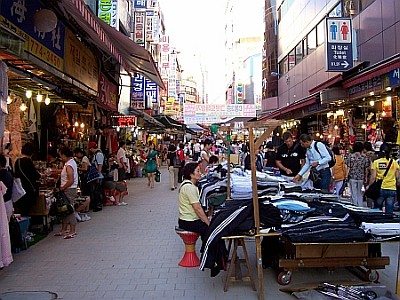
Olympic sites
The Olympic games of Seoul were held in 1988. Korea was ranked 4th (behind USSR, East Germany and the United States). Among the Olympic sites, there is mainly the Olympic Stadium and the Olympic Park.
Prehistoric and historic sites
At amsa-dong, you can visit a prehistoric site with reconstructions of Neolithic huts. At Seokchon, there are tombs of the Baekje period (4th or 5th century AD).
Mountains
Seoul is surrounded by mountains where Koreans like to go on walks as Bukhansan (map recommended) or Gwanaksan. There are several Buddhist temples there : at Bukhansan Sunggasa temple is worth seeing.
Others
-
Seoul forest : it is a large park with deers.
-
Banpo bridge (water jets) / it does not work on winter
-
Amusement parks : lotte world, seoul land.
-
The "american" district in itaewon with shops and restaurants.
-
The "french" district in seorae maheul with pavements painted with the French flag colors : "blue-white-red".
